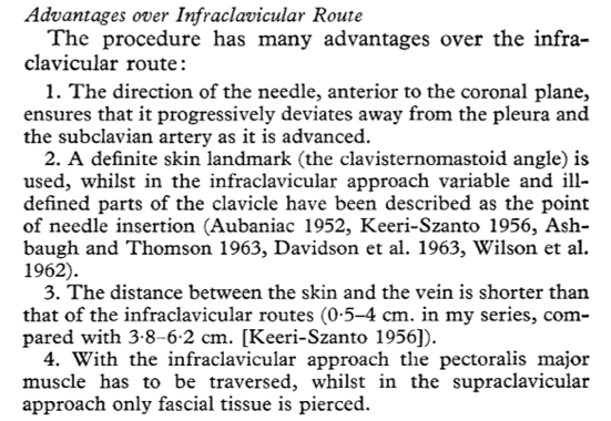Subclavian Access & Confirmation
Subclavian Access
- Can be approached from below (infraclavicular) or above (supraclavicular)
- Becomes axillary vein after crossing first rib
- Clavicle is barrier to ultrasound use for true subclavian but does visualize axillary, pleural line

Narration
So subclavian central venous access is often performed blindly and it can be challenging to visualize the subclavian vein beneath the bony clavicle, but it can be approached either from below infraclavicular or above supraclavicular and ultrasound can be helpful for both of these approaches. Keep in mind that the subclavian vein becomes the axillary vein after it crosses the first rib and sometimes this is what you are visualizing and accessing. In this clip we can actually see that vein in long axis and we're also seeing the pleura which is pretty close, about a centimeter away, and that's an element you should be aware of as you are putting a needle in this area.
Supraclavicular Approach?
Described in Lancet in 1965


Narration
One thing to keep in mind is that you actually can access the subclavian vein from a supraclavicular approach and if you follow the IJ down using ultrasound you'll see it merge into the subclavian vein and it's a nice actually pretty big pocket of blood you can access - this was first described in 1965 with some advantages even using the blind approach. It's an approach I actually do use for subclavian vascular access using ultrasound.
Confirmation Of CVC Placement
Vezzani et al., “Ultrasound localization of central venous catheter and detection of postprocedural pneumothorax: An alternative to chest radiography” Crit Care Med 2010; 38:533-538.
Narration
Once you've placed a central venous catheter there is decent evidence to suggest that you can actually use the ultrasound to confirm placement, to start medications, and to make sure that you don't have a pneumothorax. We'll talk about these uses of ultrasound in other lectures, but in these two clips the one in the upper left you can see an injection of saline with bubbles and that's filling the right ventricular cavity and you can see all the bubbles mulling around in there and that shows that you're in the right place, that the medications that you are giving are going into the right side of the heart. The clip on the lower right shows lung sliding that's the visceral and parietal pleura sliding against each other and this illustrates the absence of a pneumothorax, which would be air in there that would prevent us from seeing sliding. That is a known complication of central vascular access and ultrasound can help make sure that didn't occur during the procedure.
?
main Pv# 1 , InitialPages , pix False , #Drops 0 ;
trys 0